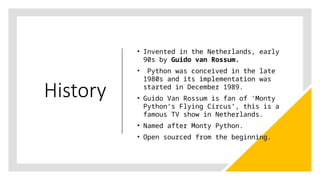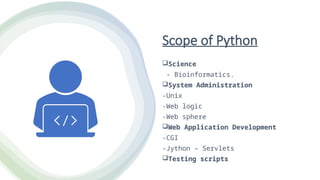Python is a high-level, interpreted programming language that emphasizes readability and simplicity,
- 2. What is Python..? • Python is a general purpose programming language that is often applied in scripting roles. • So, Python is programming language as well as scripting language. • Python is also called as Interpreted language
- 3. Difference Between Program and scripting language Program • A program is executed (i.e. the source is first compiled, and the result of that compilation is expected) • A program in general, is a sequence of instructions written so that a computer can perform certain task. Scripting • A script is interpreted. • A script is code written in a scripting language. A scripting language is nothing but a type of programming language in which we can write code to control another software application.
- 4. History • Invented in the Netherlands, early 90s by Guido van Rossum. • Python was conceived in the late 1980s and its implementation was started in December 1989. • Guido Van Rossum is fan of ‘Monty Python’s Flying Circus’, this is a famous TV show in Netherlands. • Named after Monty Python. • Open sourced from the beginning.
- 5. Scope of Python Science - Bioinformatics. System Administration -Unix -Web logic -Web sphere Web Application Development -CGI -Jython – Servlets Testing scripts
- 6. What can I do with Python…? • System programming. • Graphical User Interface Programming • Internet Scripting • Component Integration • Database Programming • Gaming, Images, XML , Robot and more.
- 7. Why do people use Python? The following primary factors cited by Python users seem to be these: Python is object-oriented Structure supports such concepts as polymorphism, operation overloading, and multiple inheritance. It's free (open source) Downloading and installing Python is free and easy Source code is easily accessible. It's powerful - Dynamic typing - Built-in types and tools - Library utilities - Third party utilities (e.g. Numeric, NumPy, SciPy) - Automatic memory management It's portable - Python runs virtually every major platform used today - As long as you have a compatible Python interpreter installed, Python programs will run in exactly the same manner, irrespective of platform.
- 8. Enough to Understand the Code Indentation matters to code meaning - Block structure indicated by indentation First assignment to a variable creates it - Variable types don’t need to be declared. - Python figures out the variable types on its own. Assignment is = and comparison is == For numbers + - * / % are as expected - Special use of + for string concatenation and % for string formatting (as in C’s printf) Logical operators are words (and, or, not) not symbols. The basic printing command is print
- 9. Python Code Execution Python’s traditional runtime execution model: source code you type is translated to byte code, which is then run by the Python Virtual Machine. Your code is automatically compiled, but then it is interpreted. Source code extension is .py Byte code extension is .pyc (compiled python code)
- 10. Running Python Once you're inside the Python interpreter, type in commands at will. Examples: >>> print 'Hello world’ Hello world # Relevant output is displayed on subsequent lines without the >>> symbol >>> x = [0,1,2] # Quantities stored in memory are not displayed by default >>> x # If a quantity is stored in memory, typing its name will display it [0,1,2] >>> 2+3 5
- 11. A Sample Code X= 34-23 #A comment. Y=“Hello” #Another one. Z=3.45 If z==3.45 or Y==“Hello”: X=X+1 Y=Y+ “World” #String Concat. print X print Y
- 12. THANK YOU









![Running Python
Once you're inside the Python interpreter, type in
commands at will.
Examples:
>>> print 'Hello world’
Hello world
# Relevant output is displayed on subsequent lines
without the >>> symbol
>>> x = [0,1,2]
# Quantities stored in memory are not displayed by
default
>>> x
# If a quantity is stored in memory, typing its name
will display it [0,1,2]
>>> 2+3
5](https://image.slidesharecdn.com/ravindereer-250323073355-01cff31c/85/Python-is-a-high-level-interpreted-programming-language-that-emphasizes-readability-and-simplicity-10-320.jpg)

